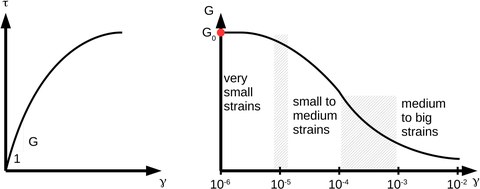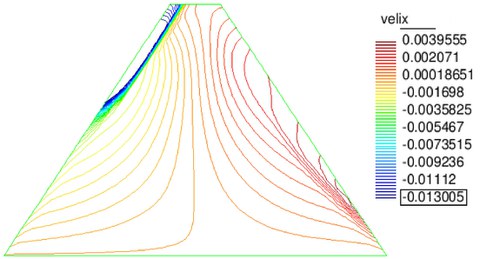Soil Dynamics
Dynamic loads can be induced in the subsoil not only by earthquakes but also by recurring train crossings on a track bed or pile-driving into the ground. For the determination of surface settlements due to dynamic loads, numerical calculations are suitable. However, numerical calculations request the application of a mathematical model, so-called constitutive model, which can depict the soil behaviour during different loading conditions.
Soil behaviour during cyclic loading is characterized by an initial volume reduction at each load reversal. This can lead to a general soil compaction. For water-saturated soils, the tendency for compaction results in the increase of pore-water pressures. In order to provide reliable deformation predictions, the constitutive model used for the recalculation of dynamic load scenarios should be able to reproduce the volume reduction upon load reversal. Furthermore, the increased soil stiffness with the change in loading direction is an aspect which also has to be considered. To determine changes in stiffness during load reversal in the laboratory, experiments with Bender-Elements or Resonant-Column tests are suitable.
The hypoplastic constitutive model is an advanced numerical model for describing soil behaviour. It is an incrementally non-linear model which can reproduce the anelastic, stress and density dependent soil behaviour. In order to determine the soil stiffness at small strains and immediately after a load reversal, the model was extended by the so-called intergranular strains (Niemunis and Herle, 1997). Applying the extended model, for very small strains the shear modulus G0 and the decrease of the shear modulus with increasing shear strain has to be determined. At the Institute of Geotechnical Engineering this is carried out by means of Bender-Element and cyclic triaxial compression tests.

Decrease of the shear modulus with increasing shear strain
Earthquakes can have a big impact on the stability of a slope. However, it is difficult to predict the behaviour of embankments under the influence of earthquakes or even to design a slope that remains stable under seismic influence. At the Institute of Geotechnical Engineering, the stability of slopes under seismic loading was numerically investigated. The validation of the applied constitutive model for the depiction of soil behaviour was carried out by recalculating centrifuge tests. Subsequently, different boundary value problems (slopes, embankments, etc.) under seismic loading conditions were numerically simulated. The numerical calculations can be used not only to study slope stability and the potential failure mechanism, but also to determine permanent deformations.

Displacement contours after a simulated earthquake in an embankment
The usage of stone columns to prevent soil liquefaction has increased in recent years. However, studies on their operating principles are hardly available. This can be explained by the fact that both numerical calculations with simple constitutive models and small-scale laboratory tests are problematic.
At the Institute of Geotechnical Engineering, the application of soil improvement columns for the prevention of soil liquefaction was numerically investigated. For this purpose, a hypoplastic constitutive model was used. The analyses focused on the influence of stiffness and water permeability of the columns.
Furthermore, the influence of column production on the surrounding soil was investigated. Centrifuge experiments were carried out and recalculated numerically in order to validate the numerical calculations. The calculation results showed that the soil improvement columns can prevent soil liquefaction due to their high stiffness as well as their high water permeability.
In order to determine the attainable bearing capacity of piles after their installation, pile load tests are necessary. Static and dynamic pile load tests are possible. The static load test is performed at 100% of the requested pile load. For this purpose, high loads or appropriate anchoring structures with tension piles are required. A cost-effective alternative is dynamic pile load testing. Here, a shock wave is induced into the pile with the aid of a free-fall hammer weight. The pile is considered as an elastic rod with one-dimensional wave propagation, whereby the load capacity can be determined. The dynamic pile load test can be performed much faster and with less weight (1-2% of the requested pile load).
At the Institute of Geotechnical Engineering, the bearing capacity of piles was investigated in order to validate the results of dynamic pile load tests. Therefore, an advanced hypoplastic constitutive model was used. As part of a cooperation project with Keller Holding GmbH, test columns were installed and their bearing capacities were tested statically and dynamically. For the calculation of the bearing capacity, extensive laboratory tests were carried out to determine the hypoplastic soil parameters for normal and very small strains.
